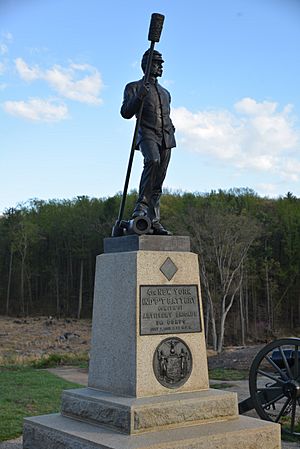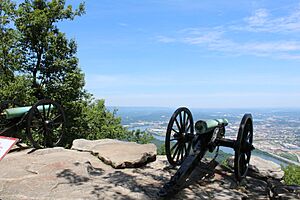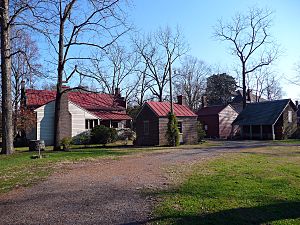American Civil War battlefield preservation facts for kids
The preservation of American Civil War battlefields means protecting the places where important battles happened. This has been going on for over 150 years in the United States. Even during the American Civil War itself, soldiers started putting up small memorials for their friends who had died.
Since those early days, many important Civil War battle sites have been saved by different groups. Today, many are looked after by the National Park Service. They are also overseen by the American Battlefield Protection Program (ABPP).
There were about 10,500 fights during the war. A 1993 government report said 384 of these were main battles. From these, some were chosen to be protected by the government. This was based on how important they were, how easy they were to visit, and if they could be saved. Many other battle sites are also cared for by state governments and private history groups.
Contents
Why We Save Battlefields
Early Efforts by Soldiers
During the Civil War, soldiers on both sides marked where their comrades fell. They also built small monuments where they won battles. These early efforts were simple. But they helped stop these places from being built on. The monuments also guided later efforts to save the sites.
Growing Interest in Preservation
Real efforts to save battlefields began in the 1890s. By then, tensions between the North and South had started to calm down. These efforts focused on the bravery of soldiers in each battle. This helped avoid arguments about the war as a whole.
Another wave of preservation happened after World War I. People were very patriotic then. Later, during the New Deal era, saving battlefields also helped create jobs. All efforts stopped during World War II.
Modern Preservation Challenges
The Civil War became linked to the Civil Rights Movement. This was because of its connection to slavery and racial issues. This made battlefield preservation a sensitive topic. The government then stepped back from these efforts.
In the 1990s, a TV show called The Civil War by Ken Burns sparked new interest. By this time, the government had not been involved for 60 years. So, private groups, especially the Civil War Trust, took over.
National Civil War Parks
The National Park Service (NPS) cares for 17 Civil War battle sites. These sites have different names. They are called National Military Parks, National Battlefields, National Battlefield Parks, and National Battlefield Sites.
It's interesting that not all these battles are seen as super important. Many other important battles don't have an official name. Some people think that choosing and promoting these sites is still a political issue today.
Some scholars and visitors complain that these federal sites might accidentally promote the 'Lost Cause' idea. This idea often focuses on the bravery of Confederate soldiers without fully explaining why the war was fought. Also, the NPS was criticized because it didn't focus much on slavery as a cause of the war until the 1990s.
Civil War National Military Parks
- Chickamauga and Chattanooga National Military Park
- Fredericksburg and Spotsylvania County Memorial National Military Park
- Gettysburg National Military Park
- Pea Ridge National Military Park
- Shiloh National Military Park
- Vicksburg National Military Park
Civil War National Battlefields
- Antietam National Battlefield
- Fort Donelson National Battlefield
- Monocacy National Battlefield
- Petersburg National Battlefield
- Stones River National Battlefield
- Tupelo National Battlefield
- Wilson's Creek National Battlefield
Civil War National Battlefield Parks
- Kennesaw Mountain National Battlefield Park
- Manassas National Battlefield Park
- Richmond National Battlefield Park
Civil War National Battlefield Sites
State and Local Battlefield Preservation
Many state governments also save Civil War battlefields. These sites are usually smaller and less famous than the federal ones. But they sometimes show stronger opinions in their history stories. This often reflects the feelings of the local area and when the preservation started. More recent state efforts try to tell battle stories in a more balanced way.
When neither the federal nor state government saves a site, private groups sometimes step in. They raise money through donations and grants. They do this if their members think the site is important. These private sites often run on their own. This can be tricky. Many of these groups are linked to organizations that promote the 'Lost Cause' idea. Examples include the Daughters of the Confederacy and the Sons of Confederate Veterans.
Even battlefields where the Union won might focus a lot on Confederate leaders and their soldiers' bravery. They might not talk much about the battle's actual outcome. The most common and balanced group saving Civil War Battlefields is the Civil War Trust. This independent group works to save Civil War history. They have led preservation efforts across the country since the late 1900s.
Images for kids







